Study on Sedimentary Environment and Organic Matter Enrichment Model of Carboniferous–Permian Marine–Continental Transitional Shale in Northern Margin of North China Basin
Abstract
1. Introduction
2. Geological Setting
3. Samples and Analysis
3.1. Samples and Experimental Method
3.2. Data Processing
4. Results
4.1. Lithological Characteristics
4.2. Organic Matter Abundance
4.3. Organic Matter Type
4.4. Element Geochemical Characteristics
5. Discussion
5.1. Provenance and Tectonic Setting
5.2. Paleoclimatic Conditions
5.3. Paleoredox Conditions
5.4. Multivariate Statistical Analysis of Organic Matter Enrichment Control Factors
5.5. Organic Matter Accumulation Model
6. Conclusions
Author Contributions
Funding
Institutional Review Board Statement
Informed Consent Statement
Data Availability Statement
Acknowledgments
Conflicts of Interest
References
- Feng, Z.J.; Dong, D.Z.; Tian, J.Q.; Qiu, Z.; Wu, W.; Zhang, C. Geochemical characteristics of longmaxi formation shale gas in the weiyuan area, Sichuan Basin, China. J. Petrol. Sci. Eng. 2018, 167, 538–548. [Google Scholar] [CrossRef]
- Wang, Z.; Zhao, J.Z.; Chen, Y.H. Analysis of palaeo–sedimentary environment and characteristics of Shanxi formation in Shenfu area on the eastern margin of Ordos basin. J. Xi’an Shiyou Univ. Nat. Sci. Ed. 2019, 34, 24–30. (In Chinese) [Google Scholar]
- Cao, Y.T.; Liu, L.; Chen, D.L.; Wang, C.; Yang, W.Q.; Kang, L.; Zhu, X.H. Partial melting during exhumation of Paleozoic retrograde eclogite in North Qaidam, western China. J. Asian Earth Sci. 2017, 148, 223–240. [Google Scholar] [CrossRef]
- Li, P.; Zhang, J.C.; Tang, X.; Huo, Z.P.; Li, Z.; Luo, K.Y.; Li, Z.M. Assessment of shale gas potential of the lower Permian transitional Shanxi-Taiyuan shales in the southern North China Basin. Aust. J. Earth Sci. 2021, 68, 262–284. [Google Scholar] [CrossRef]
- Guo, W.; Gao, J.L.; Li, H.; Kang, L.X.; Zhang, J.W.; Liu, G.H.; Liu, Y.Y. The geological and production characteristics of marine-continental transitional shale gas in China: Taking the example of shale gas from Shanxi Formation in Ordos Basin and Longtan Formation in Sichuan Basin. Miner. Explor. 2023, 14, 448–458. [Google Scholar]
- Zheng, D.Z.; Miska, S.; Ozbayoglu, E.; Zhang, J.G. Combined Experimental and Well Log Study of Anisotropic Strength of Shale. In Proceedings of the SPE Annual Technical Conference and Exhibition, San Antonio, TX, USA, 16–18 October 2023; p. D031S046R003. [Google Scholar]
- Liu, S.X.; Wu, C.F.; Li, T.; Wang, H.C. Multiple geochemical proxies controlling the organic matter accumulation of the marine-continental transitional shale: A case study of the Upper Permian Longtan Formation, western Guizhou, China. J. Nat. Gas. Sci. Eng. 2018, 56, 152–165. [Google Scholar] [CrossRef]
- Luo, W.; Hou, M.C.; Liu, X.C.; Huang, S.G.; Chao, H.; Zhang, R.; Deng, X. Geological and geochemical characteristics of marine-continental transitional shale from the Upper Permian Longtan formation, Northwestern Guizhou, China. Mar. Petrol. Geol. 2018, 89, 58–67. [Google Scholar] [CrossRef]
- Xiao, H.; Wang, T.G.; Li, M.J.; Lai, H.F.; Liu, J.G.; Mao, F.J.; Tang, Y.J. Geochemical characteristics of Cretaceous Yogou Formation source rocks and oil-source correlation within a sequence stratigraphic framework in the Termit Basin, Niger. J. Petrol. Sci. Eng. 2019, 172, 360–372. [Google Scholar] [CrossRef]
- Zhang, S.H.; Liu, C.Y.; Liang, H.; Wang, J.Q.; Bai, J.K.; Yang, M.H.; Liu, G.H.; Huang, H.X.; Guan, Y.Z. Paleoenvironmental conditions, organic matter accumulation, and unconventional hydrocarbon potential for the Permian Lucaogou Formation organicrich rocks in Santanghu Basin, NW China. Int. J. Coal Geol. 2018, 185, 44–60. [Google Scholar] [CrossRef]
- Lai, H.F.; Li, M.J.; Liu, J.G.; Mao, F.J.; Xiao, H.; He, W.X.; Yang, L. Organic geochemical characteristics and depositional models of Upper Cretaceous marine source rocks in the Termit Basin, Niger. Palaeogeogr. Palaeoclimatol. Palaeoecol. 2018, 495, 292–308. [Google Scholar] [CrossRef]
- Liang, Q.S.; Zhang, X.; Tian, J.C.; Sun, X.; Chang, H.L. Geological and geochemical characteristics of marine-continental transitional shale from the lower permian Taiyuan formation, taikang uplift, southern North China basin. Mar. Petrol. Geol. 2018, 98, 229–242. [Google Scholar] [CrossRef]
- Chen, Y.H.; Wang, Y.B.; Guo, M.Q.; Wu, H.Y.; Li, J.; Wu, W.T.; Zhao, J.Z. Differential enrichment mechanism of organic matters in the marine-continental transitional shale in northeastern Ordos Basin, China: Control of sedimentary environments. J. Nat. Gas. Sci. Eng. 2020, 83, 103625. [Google Scholar] [CrossRef]
- Peng, Y.X.; Guo, S.B. Lithofacies analysis and paleosedimentary evolution of Taiyuan Formation in Southern North China Basin. J. Petrol. Sci. Eng. 2023, 220, 111127. [Google Scholar] [CrossRef]
- Liu, P.; Zhang, T.Q.; Xu, C.; Wang, X.F.; Liu, C.J.; Guo, R.L.; Lin, H.F.; Yan, M.; Qin, L.; Li, Y. Organic matter inputs and depositional palaeoenvironment recorded by biomarkers of marine-terrestrial transitional shale in the Southern North China Basin. Geol. J. 2022, 57, 1617–1627. [Google Scholar] [CrossRef]
- Nie, H.K.; Chen, Q.; Li, P.; Dang, W.; Zhang, J.C. Shale gas potential of Ordovician marine Pingliang shale and Carboniferous–Permian transitional Taiyuan-Shanxi shales in the Ordos Basin, China. Aust. J. Earth Sci. 2023, 70, 411–422. [Google Scholar] [CrossRef]
- Lash, G.G.; Blood, D.R. Organic matter accumulation, redox, and diagenetic history of the Marcellus Formation, southwestern Pennsylvania, Appalachian basin. Mar. Petrol. Geol. 2014, 57, 244–263. [Google Scholar] [CrossRef]
- Liu, W.Q.; Yao, J.X.; Tong, J.N.; Qiao, Y.; Chen, Y. Organic matter accumulation on the Dalong Formation (Upper Permian) in western Hubei, South China: Constraints from multiple geochemical proxies and pyrite morphology. Palaeogeogr. Palaeocl. 2019, 514, 677–689. [Google Scholar] [CrossRef]
- Shang, F.H.; Zhu, Y.M.; Hu, Q.H.; Wang, Y.; Li, W.; Liu, R.Y.; Gao, H.T. Factors controlling organic-matter accumulation in the Upper Ordovician-Lower Silurian organic-rich shale on the northeast margin of the Upper Yangtze platform: Evidence from petrographic and geochemical proxies. Mar. Petrol. Geol. 2020, 121, 104597. [Google Scholar] [CrossRef]
- Li, Y.; Wang, Z.S.; Gan, Q.; Niu, X.L.; Xu, W.K. Paleoenvironmental conditions and organic matter accumulation in Upper Paleozoic organic-rich rocks in the east margin of the Ordos Basin, China. Fuel 2019, 252, 172–187. [Google Scholar] [CrossRef]
- Qi, Y.; Ju, Y.W.; Tan, J.Q.; Bowen, L.; Cai, C.F.; Yu, K.; Zhu, H.J.; Huang, C.; Zhang, W.L. Organic matter provenance and depositional environment of marine-to-continental mudstones and coals in eastern Ordos Basin, China—Evidence from molecular geochemistry and petrology. Int. J. Coal Geol. 2020, 217, 103345. [Google Scholar] [CrossRef]
- Algeo, T.J.; Liu, J.S. A re-assessment of elemental proxies for paleoredox analysis. Chem. Geol. 2020, 540, 119549. [Google Scholar] [CrossRef]
- Wu, B. The sedimentary geochemical characteristics and geological significance of the Wufeng–Longmaxi Formation accumulation of organic matter black shale on the Southeastern Sichuan Basin, China. Geofluids 2022, 22, 1900158. [Google Scholar] [CrossRef]
- Bai, J.K.; Zhang, S.H.; Liu, C.Y.; Jia, L.B.; Luo, K.Y.; Jiang, T.; Peng, H. Mineralogy and geochemistry of the Middle Permian Pingdiquan Formation black shales on the eastern margin of the Junggar Basin, north–west China: Implications for palaeoenvironmental and organic matter accumulation analyses. Geo. J. 2022, 57, 1989–2006. [Google Scholar] [CrossRef]
- Zou, C.N.; Zhu, R.K.; Chen, Z.Q.; Ogg, J.G.; Wu, S.T.; Dong, D.Z.; Qiu, Z.; Wang, Y.M.; Wang, L.; Lin, S.H.; et al. Organic-matter-rich shales of China. Earth Sci. Rev. 2019, 189, 51–78. [Google Scholar] [CrossRef]
- Jia, S.X.; Zhang, C.K.; Zhao, J.R.; Fang, S.M.; Liu, Z.; Zhao, J.M. Crustal Structure of the Rift-Depression Basin and Yanshan Uplift in the Northeast Part of North China. Chin. J. Geophys. 2009, 52, 51–63. [Google Scholar]
- Chen, Y.H.; Zhu, Z.W.; Zhang, L. Control actions of sedimentary environments and sedimentation rates on lacustrine oil shale distribution, an example of the oil shale in the Upper Triassic Yanchang Formation, southeastern Ordos Basin (NW China). Mar. Petrol. Geol. 2019, 102, 508–520. [Google Scholar] [CrossRef]
- Li, Y.; Yang, J.H.; Pan, Z.J.; Meng, S.Z.; Wang, K.; Niu, X.L. Unconventional Natural Gas Accumulations in Stacked Deposits: A Discussion of Upper Paleozoic Coal-Bearing Strata in the East Margin of the Ordos Basin, China. Acta Geol. Sin.-Engl. 2019, 93, 111–129. [Google Scholar] [CrossRef]
- Ding, J.H.; Zhang, J.C.; Huo, Z.P.; Shen, B.J.; Shi, G.; Yang, Z.H.; Li, X.Q.; Li, C.X. Controlling factors and formation models of organic matter accumulation for the Upper Permian Dalong Formation black shale in the Lower Yangtze region, South China: Constraints from geochemical evidence. ACS Omega 2021, 6, 3681–3692. [Google Scholar] [CrossRef]
- Yan, M.; Feng, J.L. Depositional environment variations and organic matter accumulation of the first member of the Qingshankou formation in the southern Songliao Basin, China. Front. Earth Sci. 2023, 11, 1249787. [Google Scholar]
- Wei, W.; Algeo, T.J. Elemental proxies for paleosalinity analysis of ancient shales and mudrocks. Geochim. Cosmochim. Acta 2020, 287, 341–366. [Google Scholar] [CrossRef]
- Zhang, L.F.; Dong, D.Z.; Qiu, Z.; Wu, C.J.; Zhang, Q.; Wang, Y.M.; Liu, D.X.; Deng, Z.; Zhou, S.W.; Pan, S.Q. Sedimentology and geochemistry of Carboniferous-Permian marine-continental transitional shales in the eastern Ordos Basin, North China. Palaeogeogr. Palaeocl. 2021, 571, 110389. [Google Scholar] [CrossRef]
- Yu, K.; Ju, Y.W.; Qian, J.; Qu, Z.H.; Shao, C.J.; Yu, K.L.; Shi, Y. Burial and thermal evolution of coal-bearing strata and its mechanisms in the southern North China Basin since the late Paleozoic. Int. J. Coal Geol. 2018, 198, 100–115. [Google Scholar] [CrossRef]
- Qi, J.F.; Yang, Q. Cenozoic structural deformation and dynamic processes of the Bohai Bay basin province, China. Mar. Petrol. Geol. 2009, 27, 757–771. [Google Scholar] [CrossRef]
- GB/T21114-2019; Chemical Analysis of Refractory Products by XRF-Fused Cast Bead Method. China Standard Press: Beijing, China, 2019.
- SY/T5163-2018; Analysis Method for Clay Minerals and Ordinary Non-Clay Minerals in Sedimentary Rocks by the X-ray Diffraction. China Standard Press: Beijing, China, 2018.
- GB/T 18602-2012; Rock pyrolysis analysis. China Standard Press: Beijing, China, 2012.
- SY/T5125-2014; Method of Identification Microscopically the Macerals of Kerogen and Indivision the Kerogen Type by Transmitted-Light and Fluorescence. China Standard Press: Beijing, China, 2014.
- Taylor, S.R.; McLennan, S.M. The geochemical evolution of the continental crust. Rev. Geophys. 1995, 33, 241–265. [Google Scholar] [CrossRef]
- Francois, R.; Honjo, S.; Manganini, S.J.; Ravizza, G.E. Biogenic barium fluxes to the deep sea: Implications for paleoproductivity reconstruction. Global Biogeochem. Cycles 1995, 9, 289–303. [Google Scholar] [CrossRef]
- Liu, J.; Yao, Y.; Liu, D.; Pan, Z.; Cai, Y. Comparison of three key marine shale reservoirs in the southeastern margin of the Sichuan Basin, SW China. Minerals 2017, 7, 179. [Google Scholar] [CrossRef]
- He, J.H.; Ding, W.L.; Jiang, Z.X.; Li, A.; Wang, R.Y.; Sun, Y.X. Logging identification and characteristic analysis of the lacustrine organic-rich shale lithofacies: A case study from the Es3L shale in the Jiyang Depression, Bohai Bay Basin, eastern China. J. Petrol. Sci. Eng. 2016, 145, 238–255. [Google Scholar] [CrossRef]
- Khaled, A.; Li, R.X.; Xi, S.L.; Zhao, B.S.; Wu, X.L.; Yu, Q.; Zhang, Y.N.; Li, D.L. Paleoenvironmental conditions and organic matter enrichment of the Late Paleoproterozoic Cuizhuang Formation dark shale in the Yuncheng Basin, North China. J. Petrol. Sci. Eng. 2022, 208, 109627. [Google Scholar] [CrossRef]
- Men, X.; Mou, C.L.; Ge, X.Y. Changes in palaeoclimate and palaeoenvironment in the Upper Yangtze area (South China) during the Ordovician–Silurian transition. Sci. Rep. 2022, 12, 13186. [Google Scholar] [CrossRef]
- Keskin, S. Geochemistry of Çamardı Formation sediments. central Anatolia (Turkey): Implication of source area weathering. provenance. and tectonic setting. Geosci. J. 2011, 15, 185–195. [Google Scholar] [CrossRef]
- McLennan, S.M. Relationships between the trace element composition of sedimentary rocks and upper continental crust. Geochem. Geophys. Geosyst. 2001, 2, 2000GC000109. [Google Scholar] [CrossRef]
- Taylor, S.R.; Mclennan, S.M. The Continental Crust: Its Composition and Evolution. An Examination of the Geochemical Record Preserved in Sedimentary Rocks; Blackwell Scientific: Oxford, UK, 1985. [Google Scholar]
- Roser, B.P.; Korsch, R.J. Provenance signatures of sandstoneemudstone suites determined using discriminant function analysis of major element data. Chem. Geol. 1988, 67, 119–139. [Google Scholar] [CrossRef]
- Floyd, P.A.; Leveridge, B.E. Tectonic environments of the Devonian Gramscatho basin, south Cornwall: Framework mode and geochemical evidence from turbidite sandstones. Jour Geol. Soc. London 1987, 144, 531–542. [Google Scholar] [CrossRef]
- Bhatia, M.R.; Crook, K.A.W. Trace element characteristics of graywackes and tectonic setting discrimination of sedimentary basins. Contrib. Mineral. Petrol. 1986, 92, 181–193. [Google Scholar] [CrossRef]
- Wang, J.; Guo, S. Comparison of geochemical characteristics of marine facies, marine-continental transitional facies and continental facies shale in typical areas of China and their control over organic-rich shale. Energy Source Part A 2020, 1–13. [Google Scholar] [CrossRef]
- Algeo, T.J.; Tribovillard, N. Environmental analysis of paleoceanographic systems based on molybdenum-uranium covariation. Chem. Geol. 2009, 268, 211–225. [Google Scholar] [CrossRef]
- Yin, K.; Xu, J.; Li, X. A new grey comprehensive relational model based on weighted mean distance and induced intensity and its application. Grey Syst. 2019, 9, 374–384. [Google Scholar] [CrossRef]
- Si, S.L.; You, X.Y.; Liu, H.C.; Ping, Z. DEMATEL Technique: A Systematic Review of the State-of-the-Art Literature on Methodologies and Applications. Math. Probl. Eng. 2018, 2018, 3696457. [Google Scholar] [CrossRef]
- González, J.; Peña, D.; Romera, R. A robust partial least squares regression method with applications. J. Chemometr. 2009, 23, 78–90. [Google Scholar] [CrossRef]
- Fan, Y.L.; Xiang, Y.Y.; Guo, Z.J. Adaptive efficient and double-robust regression based on generalized empirical likelihood. Commun. Stat-Simul. C 2021, 52, 3079–3094. [Google Scholar]
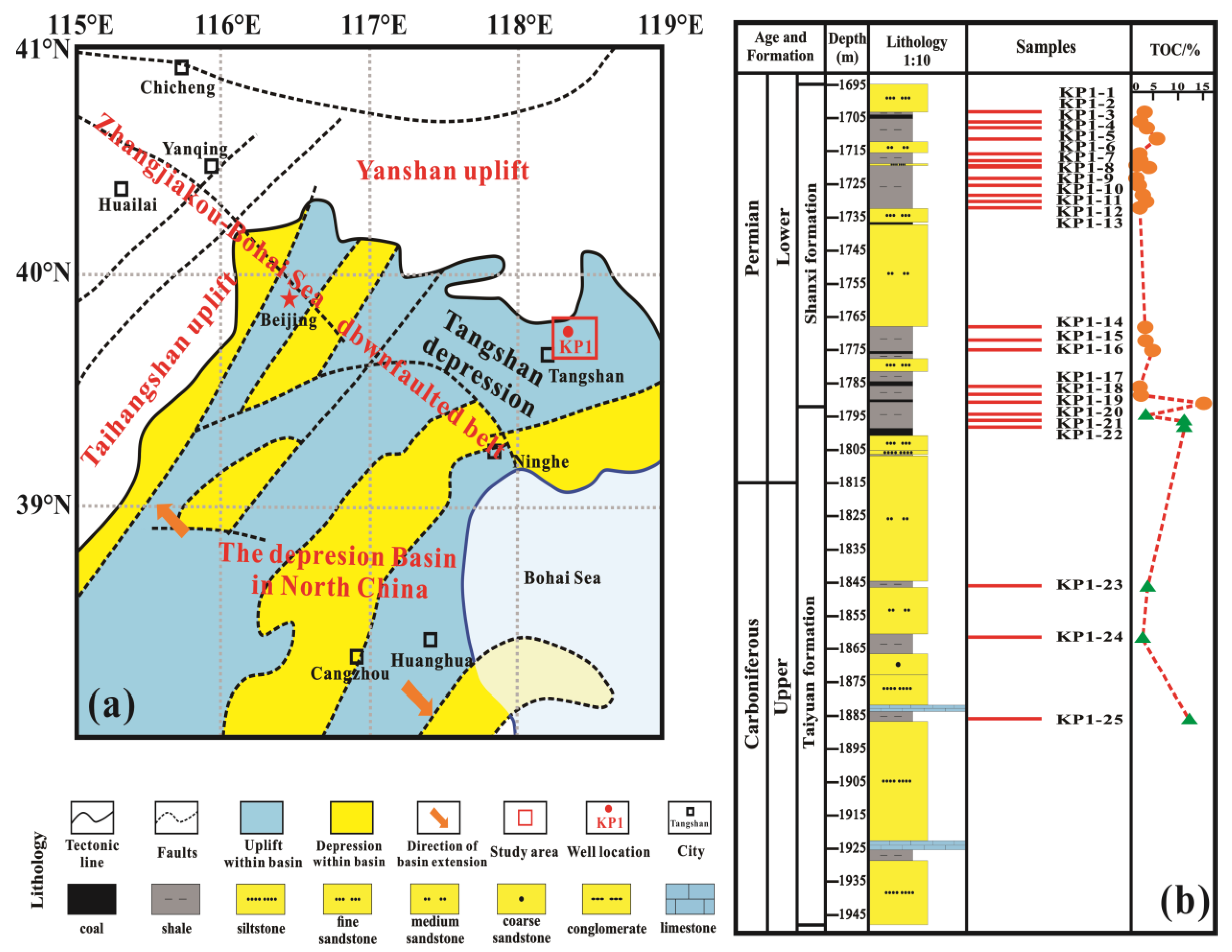

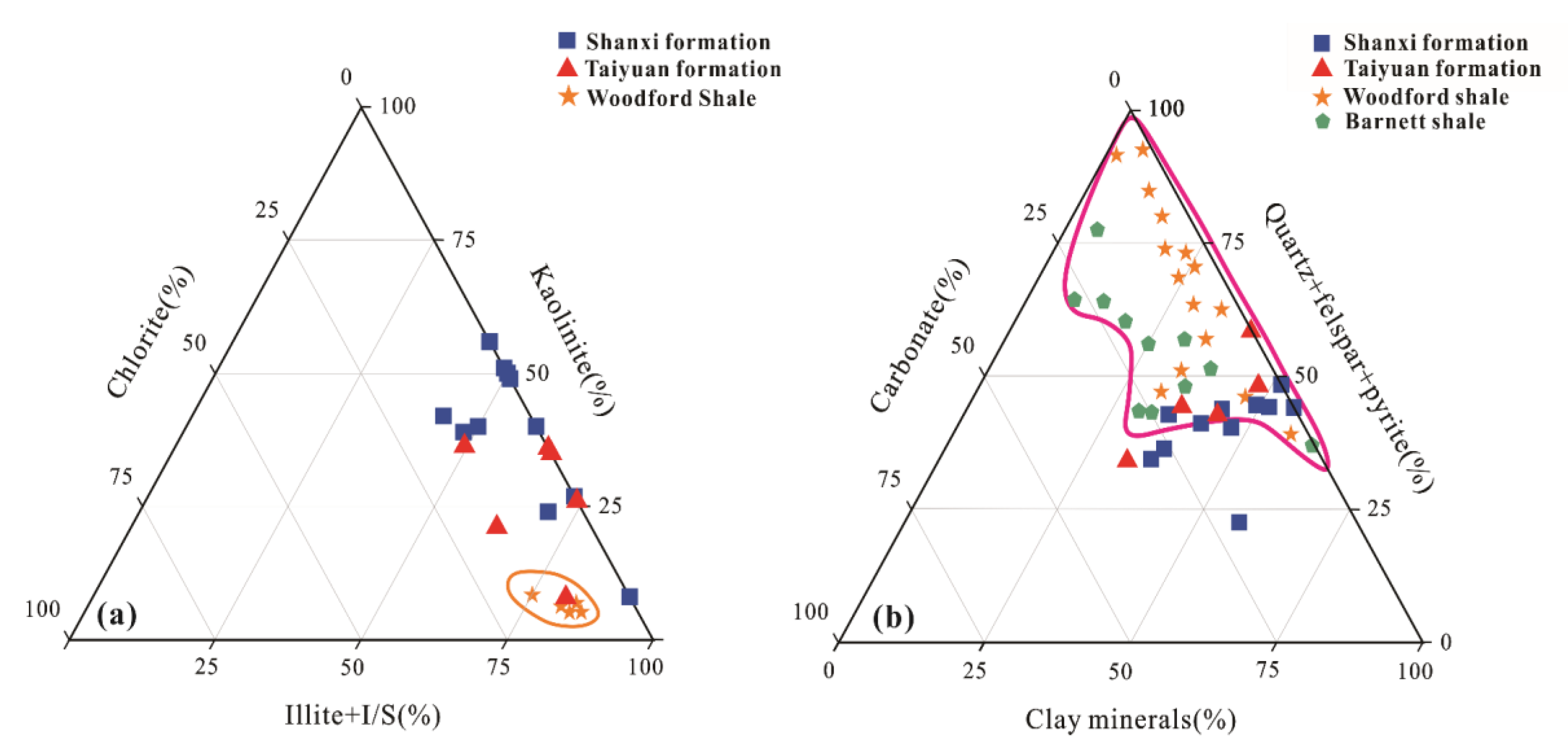
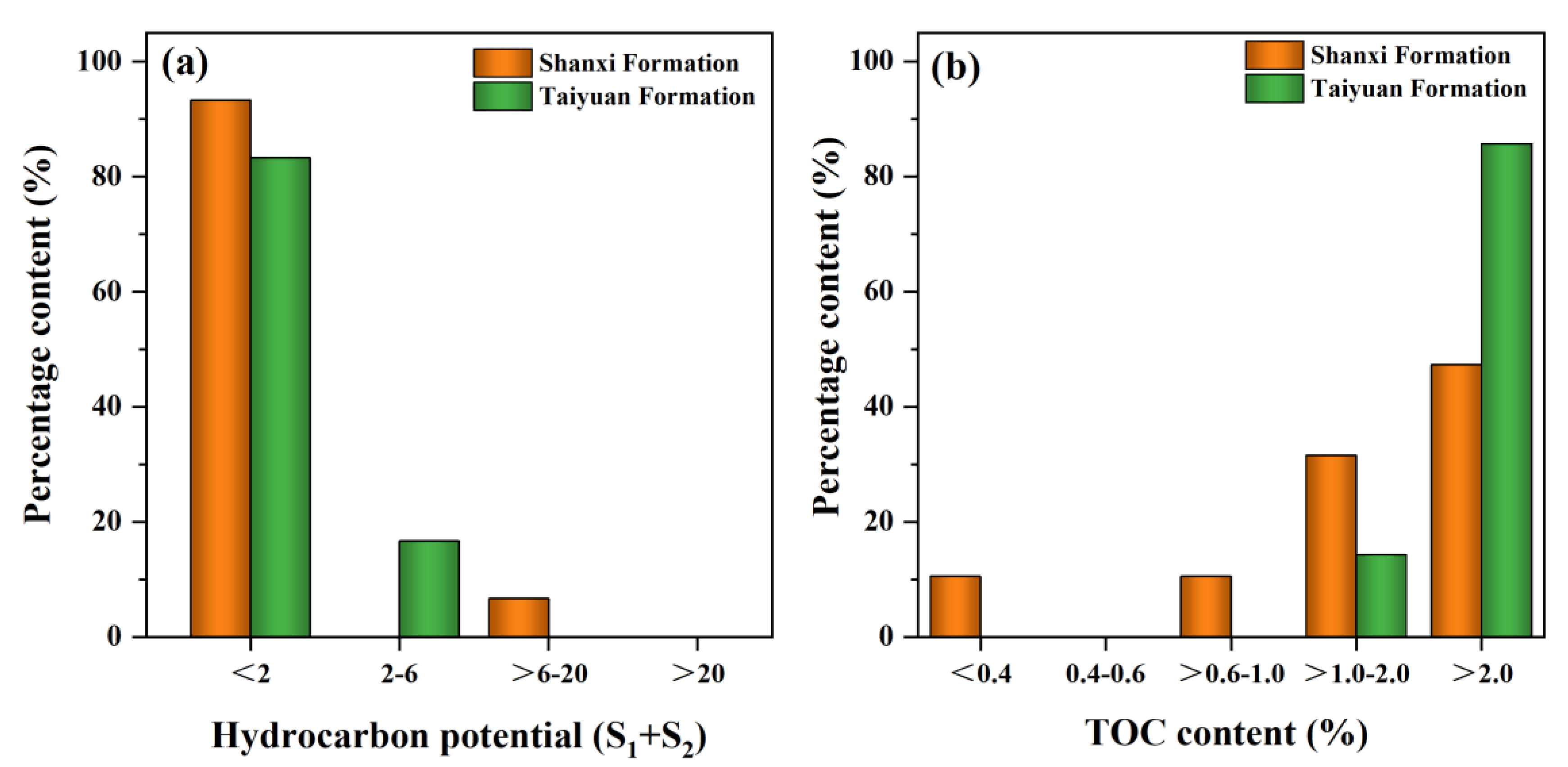

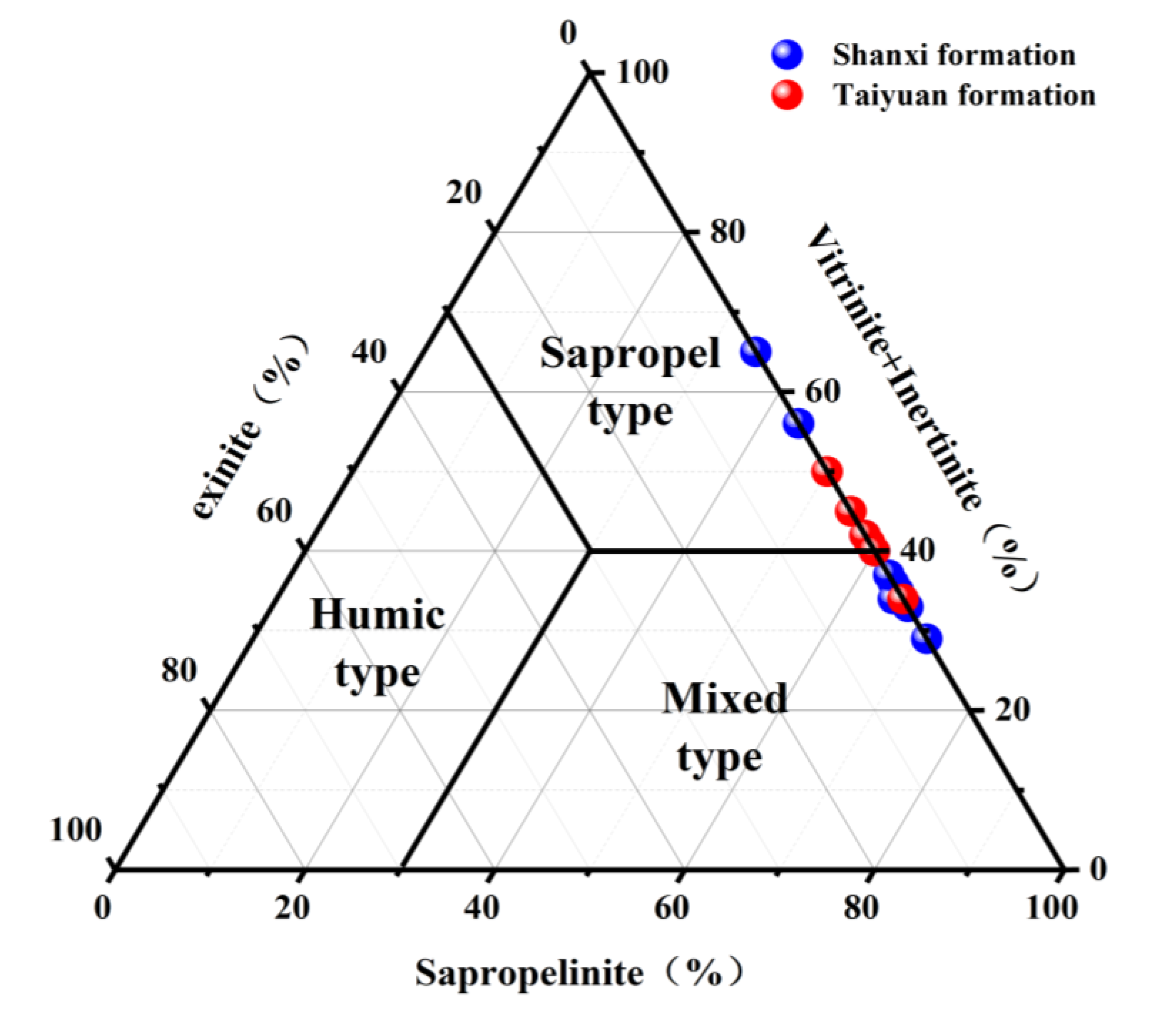
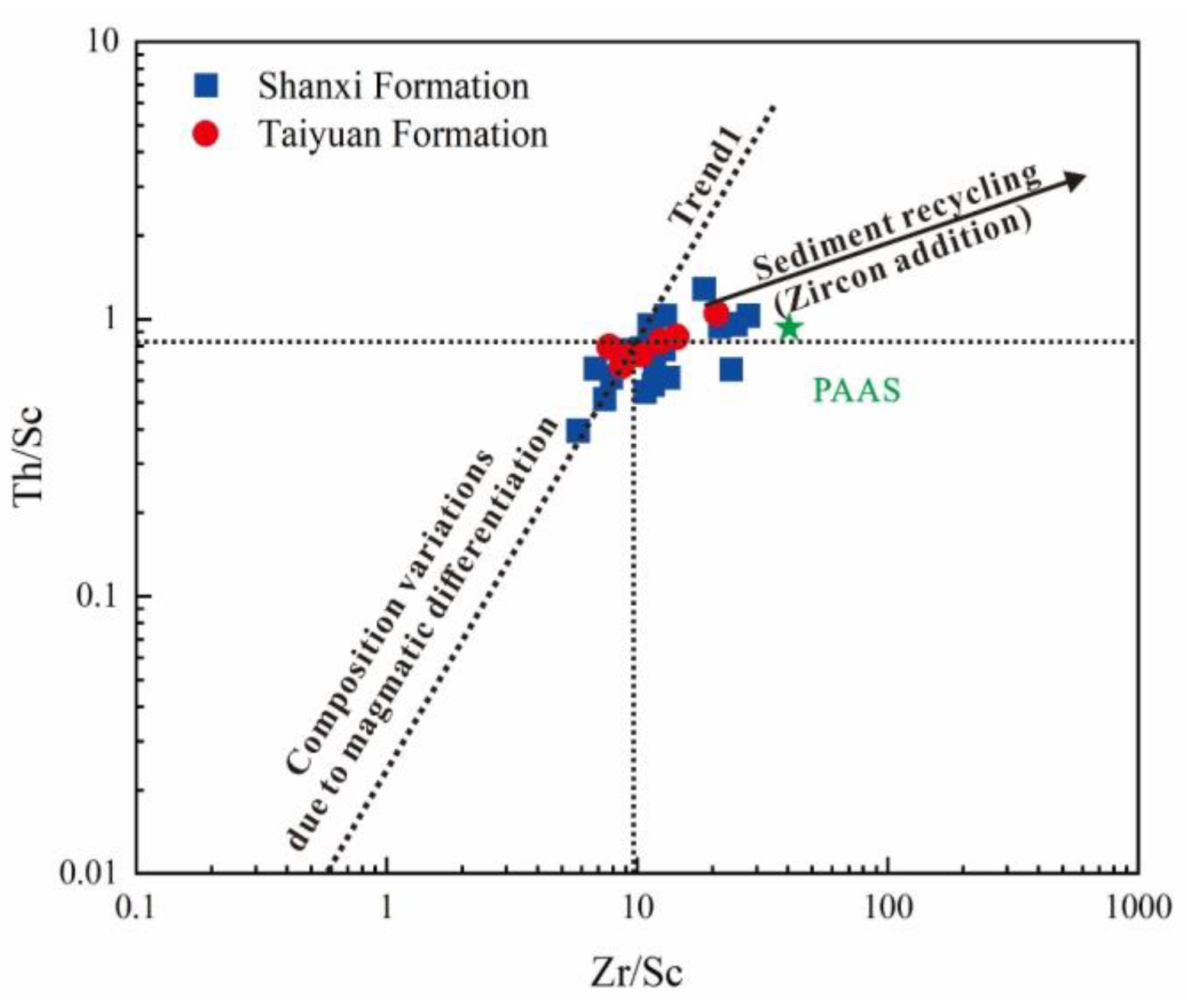
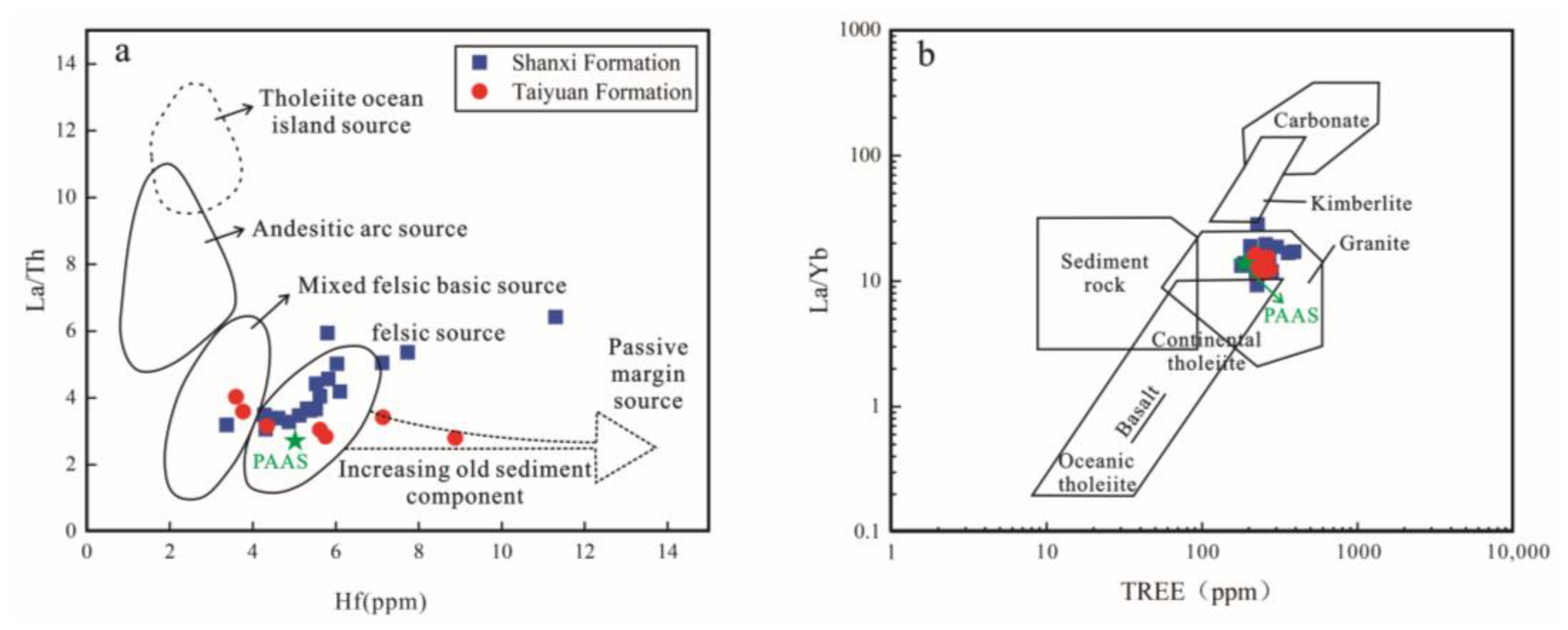


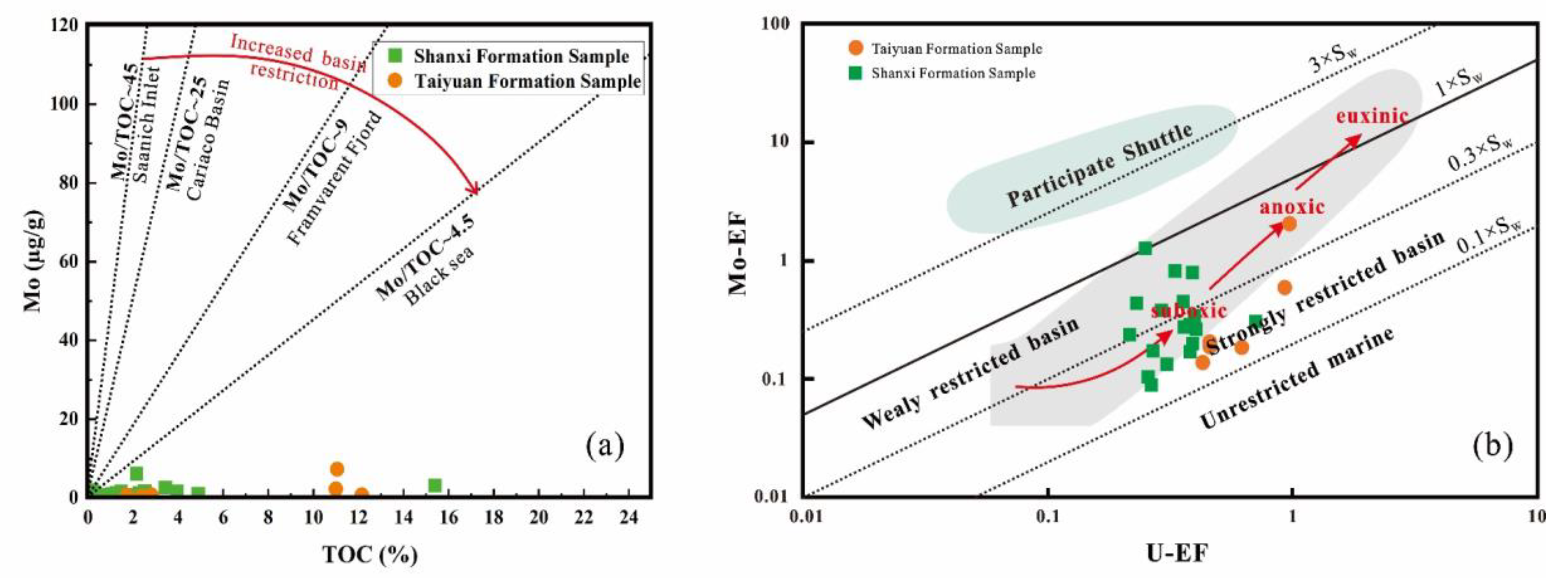
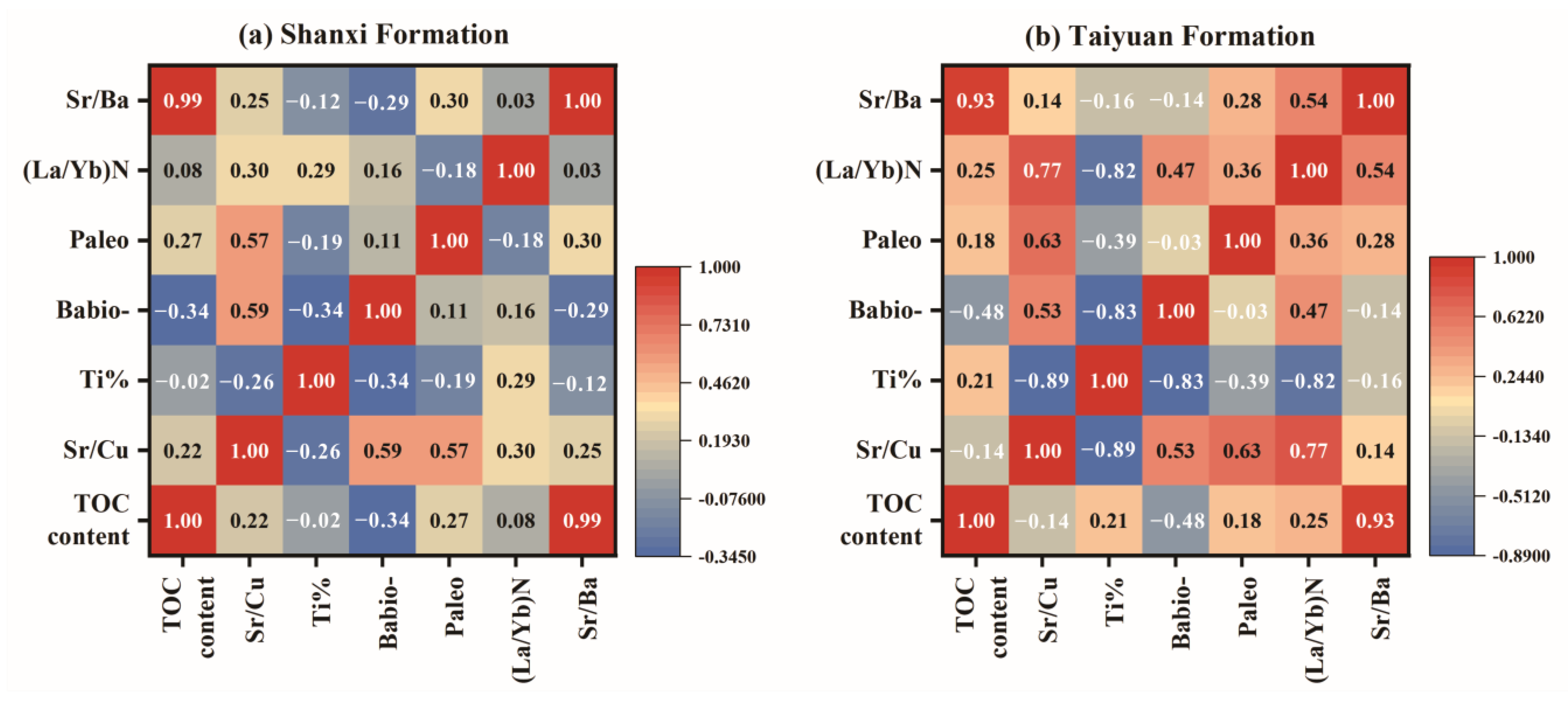


| Index | Non-Source Rocks | Poor Source Rocks | Medium Source Rocks | Good Hydrocarbon Source Rocks |
|---|---|---|---|---|
| TOC (%) | <0.4 | 0.4–0.6 | >0.6–1.0 | >1.0–2.0 |
| S1 + S2(mg/g) | - | <2 | 2–6 | >6–20 |
| Stratum | Sample No. | Depth (m) | TOC (%) | Na (a) (wt%) | Mg (b) (wt%) | Al (c) (wt%) | Si (d) (wt%) | Mn (e) (wt%) | K (f) (wt%) | Ca (g) (wt%) | Ti (h) (wt%) | P (i) (wt%) | Fe (j) (wt%) |
|---|---|---|---|---|---|---|---|---|---|---|---|---|---|
| Shanxi Formation | KP1-1 | 1703.56 | 2.15 | 0.56 | 1.36 | 25.92 | 59.12 | 0.11 | 4.02 | 0.40 | 1.25 | 0.09 | 7.17 |
| KP1-2 | 1706.38 | 1.22 | 0.50 | 1.88 | 26.70 | 59.36 | 0.04 | 3.80 | 0.43 | 1.17 | 0.15 | 5.97 | |
| KP1-3 | 1708.5 | 2.52 | 0.52 | 2.51 | 22.07 | 57.84 | 0.20 | 4.10 | 1.18 | 1.15 | 0.13 | 10.31 | |
| KP1-4 | 1711.73 | 4.89 | 0.64 | 6.07 | 18.31 | 50.64 | 0.23 | 4.34 | 9.91 | 0.84 | 0.14 | 8.88 | |
| KP1-5 | 1716.06 | 0.87 | 0.62 | 1.47 | 21.60 | 66.57 | 0.02 | 4.27 | 0.23 | 0.81 | 0.09 | 4.32 | |
| KP1-6 | 1717.97 | 1.47 | 0.55 | 1.69 | 22.41 | 65.04 | 0.02 | 4.87 | 0.21 | 0.83 | 0.06 | 4.31 | |
| KP1-7 | 1719.68 | 0.2 | 0.93 | 3.75 | 24.80 | 53.56 | 0.06 | 5.74 | 4.76 | 1.00 | 0.13 | 5.26 | |
| KP1-8 | 1720.37 | 3.43 | 0.48 | 4.21 | 18.37 | 60.53 | 0.14 | 2.83 | 5.63 | 1.11 | 0.16 | 6.56 | |
| KP1-9 | 1723.72 | 0.3 | 0.36 | 1.60 | 17.68 | 45.81 | 0.55 | 2.87 | 0.93 | 0.89 | 0.15 | 29.17 | |
| KP1-10 | 1725.77 | 0.86 | 0.43 | 1.70 | 22.86 | 60.13 | 0.26 | 3.94 | 0.57 | 1.32 | 0.13 | 8.66 | |
| KP1-11 | 1728.37 | 1.72 | 0.40 | 4.46 | 19.09 | 51.60 | 0.29 | 3.45 | 6.01 | 1.17 | 0.22 | 13.32 | |
| KP1-12 | 1730.26 | 2.52 | 0.52 | 4.99 | 20.61 | 55.57 | 0.13 | 3.96 | 7.58 | 1.26 | 0.13 | 5.24 | |
| KP1-13 | 1732.41 | 1.03 | 0.54 | 1.72 | 22.88 | 58.20 | 0.19 | 4.40 | 1.05 | 1.12 | 0.15 | 9.75 | |
| KP1-14 | 1768.15 | 2.27 | 0.44 | 1.71 | 24.32 | 55.21 | 0.37 | 4.17 | 0.86 | 1.14 | 0.18 | 11.59 | |
| KP1-15 | 1772.01 | 2.31 | 0.42 | 1.60 | 25.92 | 50.68 | 0.46 | 4.06 | 0.88 | 1.21 | 0.20 | 14.57 | |
| KP1-16 | 1774.97 | 3.95 | 0.57 | 0.73 | 29.92 | 59.73 | 0.02 | 2.57 | 0.14 | 1.31 | 0.05 | 4.97 | |
| KP1-17 | 1785.92 | 1.04 | 0.52 | 2.70 | 21.81 | 57.48 | 0.15 | 5.14 | 2.53 | 0.95 | 0.30 | 8.42 | |
| KP1-18 | 1788.44 | 1.24 | 0.49 | 3.52 | 19.77 | 55.23 | 0.36 | 5.15 | 2.96 | 0.88 | 0.15 | 11.48 | |
| KP1-19 | 1790.80 | 15.39 | 0.67 | 1.38 | 20.98 | 44.52 | 0.06 | 2.92 | 1.57 | 1.00 | 0.06 | 26.82 | |
| Taiyuan Formation | KP1-20 | 1794.50 | 2.36 | 0.55 | 6.91 | 17.08 | 52.81 | 0.18 | 3.75 | 10.58 | 0.84 | 0.18 | 7.12 |
| KP1-21 | 1796.43 | 11.05 | 0.63 | 2.78 | 19.08 | 56.22 | 0.19 | 4.71 | 2.58 | 0.77 | 0.12 | 12.92 | |
| KP1-22 | 1798.35 | 11 | 0.79 | 1.89 | 20.50 | 52.94 | 0.11 | 4.52 | 1.47 | 0.88 | 0.08 | 16.83 | |
| KP1-23 | 1846.15 | 2.82 | 0.42 | 2.29 | 20.67 | 53.04 | 0.19 | 5.13 | 0.59 | 0.98 | 0.17 | 16.51 | |
| KP1-24 | 1861.47 | 1.71 | 0.44 | 2.31 | 19.68 | 61.69 | 0.08 | 7.13 | 0.29 | 1.00 | 0.06 | 7.32 | |
| KP1-25 | 1885.79 | 12.15 | 0.47 | 1.41 | 22.64 | 64.92 | 0.02 | 4.67 | 0.57 | 1.31 | 0.10 | 3.90 |
| Stratum | Sample No. | Depth (m) | Sc(10−6) | V(10−6) | Co(10−6) | Ni(10−6) | Cu(10−6) | Zn(10−6) | Rb(10−6) | Sr(10−6) | Y(10−6) | Zr(10−6) | Nb(10−6) | Mo(10−6) | Cs(10−6) | Ba(10−6) |
|---|---|---|---|---|---|---|---|---|---|---|---|---|---|---|---|---|
| Shanxi Formation | KP1-1 | 1703.56 | 11.6 | 134 | 47 | 72.3 | 49.3 | 88.6 | 73.4 | 142 | 30.3 | 288 | 15.8 | 6.17 | 8.36 | 668 |
| KP1-2 | 1706.38 | 11.3 | 145 | 11.7 | 23.7 | 66 | 109 | 68.6 | 128 | 24.1 | 242 | 15 | 0.52 | 6.14 | 433 | |
| KP1-3 | 1708.50 | 20.5 | 155 | 22.5 | 36 | 65.7 | 132 | 73.8 | 136 | 32.6 | 220 | 15.2 | 1.08 | 7.42 | 485 | |
| KP1-4 | 1711.73 | 18 | 166 | 13.3 | 21 | 26.2 | 103 | 87.7 | 434 | 28.6 | 155 | 12.3 | 1.04 | 6.35 | 645 | |
| KP1-5 | 1716.06 | 12.4 | 102 | 10.5 | 19.9 | 55 | 82.8 | 80.4 | 98 | 19 | 161 | 14.4 | 0.7 | 6.69 | 505 | |
| KP1-6 | 1717.97 | 13.5 | 136 | 16.8 | 28.2 | 58.9 | 68.4 | 92.2 | 118 | 26.1 | 151 | 15.6 | 1.58 | 10.3 | 507 | |
| KP1-7 | 1719.68 | 18.1 | 48.2 | 6.66 | 9.06 | 14.9 | 114 | 81.6 | 257 | 43.9 | 430 | 18.4 | 2.02 | 5.57 | 880 | |
| KP1-8 | 1720.37 | 18.4 | 113 | 11.5 | 18.7 | 45.3 | 141 | 74.4 | 193 | 37 | 246 | 13.5 | 2.72 | 5.47 | 416 | |
| KP1-9 | 1723.72 | 25.8 | 163 | 32.6 | 30.9 | 52.9 | 87.8 | 60.3 | 138 | 34.4 | 150 | 12.5 | 0.56 | 7.38 | 383 | |
| KP1-10 | 1725.77 | 18.3 | 171 | 20.8 | 37 | 75.6 | 107 | 64.9 | 136 | 32.9 | 215 | 16.7 | 0.38 | 8.46 | 366 | |
| KP1-11 | 1728.37 | 24.9 | 144 | 20.7 | 35.1 | 66.5 | 121 | 83.4 | 175 | 37.1 | 185 | 14.4 | 0.7 | 6.69 | 414 | |
| KP1-12 | 1730.26 | 13.4 | 118 | 31.1 | 53.8 | 64.5 | 139 | 81.8 | 165 | 26.5 | 172 | 17.2 | 1.73 | 7.07 | 364 | |
| KP1-13 | 1732.41 | 16.3 | 175 | 23.6 | 35 | 66.4 | 91.8 | 75.2 | 146 | 30.8 | 189 | 14.9 | 0.57 | 11.2 | 386 | |
| KP1-14 | 1768.15 | 17.6 | 139 | 22.4 | 33 | 57.8 | 108 | 97 | 230 | 30.7 | 173 | 14.8 | 1.25 | 7.83 | 394 | |
| KP1-15 | 1772.01 | 7.26 | 164 | 21.8 | 27 | 64.1 | 96 | 47.5 | 192 | 22.2 | 202 | 16.3 | 1.14 | 6.75 | 313 | |
| KP1-16 | 1774.97 | 9.89 | 159 | 25 | 43.2 | 18.9 | 224 | 46 | 193 | 16.3 | 183 | 13.8 | 1.62 | 5.38 | 363 | |
| KP1-17 | 1785.92 | 22 | 164 | 24 | 43.4 | 45.9 | 98.5 | 118 | 282 | 30.2 | 174 | 14.4 | 0.96 | 10 | 514 | |
| KP1-18 | 1788.44 | 21.3 | 157 | 20.2 | 28.9 | 41.4 | 54 | 93.3 | 260 | 32 | 145 | 14 | 1.26 | 8.97 | 511 | |
| KP1-19 | 1790.80 | 12.9 | 93.4 | 16.9 | 41.2 | 34.2 | 77.4 | 46.3 | 247 | 20.3 | 134 | 9.43 | 3.18 | 4.57 | 276 | |
| Taiyuan Formation | KP1-20 | 1794.50 | 15.6 | 116 | 18.7 | 27.9 | 39.5 | 153 | 77.5 | 304 | 23.5 | 162 | 11.4 | 0.44 | 5.79 | 514 |
| KP1-21 | 1796.43 | 16.9 | 144 | 18.7 | 58.5 | 46.4 | 128 | 81.9 | 294 | 32.4 | 131 | 10.7 | 7.29 | 7.17 | 602 | |
| KP1-22 | 1798.35 | 15.1 | 148 | 18.6 | 57.2 | 43.1 | 92.8 | 71.3 | 260 | 26.3 | 131 | 10.3 | 2.27 | 5.15 | 474 | |
| KP1-23 | 1846.15 | 21.4 | 162 | 18.5 | 29.4 | 50.2 | 120 | 93.8 | 223 | 38.7 | 202 | 15.2 | 0.79 | 11.4 | 535 | |
| KP1-24 | 1861.47 | 16.6 | 132 | 19.6 | 25 | 48.4 | 114 | 114 | 168 | 32.4 | 239 | 17.6 | 0.68 | 12.8 | 568 | |
| KP1-25 | 1885.79 | 15 | 114 | 8.25 | 22.3 | 58.5 | 24.6 | 75.1 | 128 | 30.1 | 312 | 16.3 | 0.78 | 10.6 | 314 |
| Ratios | Index | KP1 Well Formation | Wet and Warm | Dry and Hot | |
|---|---|---|---|---|---|
| C2t | P1s | ||||
| Paleoclimatic | Sr/Cu | 1.78 (a)–17.25 (b) (5.13) (c) | 2.18 (a)–7.70 (b) (2.18) (c) | 1–10 | >10 |
| Rb/Sr | 0.19 (a)–0.82 (b) (0.44) (c) | 0.25 (a)–0.68 (b) (0.42) (c) | - | ||
| Stratum | Sample No. | TOC (%) | Sr/Cu | Ti (%) | Babio | Paleo- | Mo-EF | U-EF |
|---|---|---|---|---|---|---|---|---|
| Shanxi Formation | KP1-1 | 2.15% | 2.88 | 1.25% | 657.89 | 0.32 | 1.28 | 0.25 |
| KP1-2 | 1.22% | 1.94 | 1.17% | 422.59 | 0.38 | 0.10 | 0.25 | |
| KP1-3 | 2.52% | 2.07 | 1.15% | 476.39 | 0.30 | 0.26 | 0.40 | |
| KP1-4 | 4.89% | 16.56 | 0.84% | 637.86 | 0.52 | 0.30 | 0.70 | |
| KP1-5 | 0.87% | 1.78 | 0.81% | 496.57 | 0.22 | 0.17 | 0.27 | |
| KP1-6 | 1.47% | 2.00 | 0.83% | 498.26 | 0.27 | 0.38 | 0.29 | |
| KP1-7 | 0.20% | 17.25 | 1.00% | 870.33 | 0.48 | 0.44 | 0.23 | |
| KP1-8 | 3.43% | 4.26 | 1.11% | 408.84 | 0.36 | 0.79 | 0.39 | |
| KP1-9 | 0.30% | 2.61 | 0.89% | 376.11 | 0.50 | 0.17 | 0.38 | |
| KP1-10 | 0.86% | 1.80 | 1.32% | 357.08 | 0.34 | 0.09 | 0.27 | |
| KP1-11 | 1.72% | 2.63 | 1.17% | 406.56 | 0.44 | 0.20 | 0.39 | |
| KP1-12 | 2.52% | 2.56 | 1.26% | 355.96 | 0.24 | 0.45 | 0.35 | |
| KP1-13 | 1.03% | 2.20 | 1.12% | 377.08 | 0.32 | 0.13 | 0.30 | |
| KP1-14 | 2.27% | 3.98 | 1.14% | 384.51 | 0.28 | 0.28 | 0.36 | |
| KP1-15 | 2.31% | 3.00 | 1.21% | 302.89 | 0.47 | 0.24 | 0.21 | |
| KP1-16 | 3.95% | 10.21 | 1.31% | 351.33 | 0.39 | 0.29 | 0.38 | |
| KP1-17 | 1.04% | 6.14 | 0.95% | 505.49 | 0.37 | 0.24 | 0.40 | |
| KP1-18 | 1.24% | 6.28 | 0.88% | 503.29 | 0.46 | 0.34 | 0.40 | |
| KP1-19 | 15.39% | 7.22 | 1.00% | 267.82 | 0.48 | 0.81 | 0.33 | |
| Taiyuan Formation | KP1-20 | 2.36% | 7.70 | 0.84% | 507.34 | 0.48 | 0.14 | 0.43 |
| KP1-21 | 11.05% | 6.34 | 0.77% | 594.56 | 0.43 | 2.05 | 0.96 | |
| KP1-22 | 11% | 6.03 | 0.88% | 466.01 | 0.48 | 0.59 | 0.92 | |
| KP1-23 | 2.82% | 4.44 | 0.98% | 526.94 | 0.48 | 0.20 | 0.46 | |
| KP1-24 | 1.71% | 3.47 | 1.00% | 560.33 | 0.24 | 0.19 | 0.46 | |
| KP1-25 | 12.15% | 2.19 | 1.31% | 305.17 | 0.37 | 0.18 | 0.61 |
| Fitting Parameters | Shanxi Formation | Correlation Coefficients R2 | Taiyuan Formation | Correlation Coefficients R2 | ||||
|---|---|---|---|---|---|---|---|---|
| Parameter Value | Significance p-Value | Whether Significant | Parameter Value | Significance p-Value | Whether Significant | |||
| Sr/Cu | 0 | 0.993 | No | 0.997 | −0.002 | - | - | 0.987 |
| Ti% | 1.563 | 0.0001 | Yes | 2.95 | - | - | ||
| Babio | 0 | 0.095 | No | 0 | - | - | ||
| Paleo- | 0.001 | 0.603 | No | −0.001 | - | - | ||
| (La/Yb)N | 0 | 0.006 | Yes | 0.003 | - | - | ||
| Sr/Ba | 0.01 | 0.0001 | Yes | 0.007 | - | - | ||
| Constant value | −0.017 | 0.025 | ||||||
Disclaimer/Publisher’s Note: The statements, opinions and data contained in all publications are solely those of the individual author(s) and contributor(s) and not of MDPI and/or the editor(s). MDPI and/or the editor(s) disclaim responsibility for any injury to people or property resulting from any ideas, methods, instructions or products referred to in the content. |
© 2024 by the authors. Licensee MDPI, Basel, Switzerland. This article is an open access article distributed under the terms and conditions of the Creative Commons Attribution (CC BY) license (https://creativecommons.org/licenses/by/4.0/).
Share and Cite
Zhang, H.; Wang, Y.; Chen, H.; Zhu, Y.; Yang, J.; Zhang, Y.; Dou, K.; Wang, Z. Study on Sedimentary Environment and Organic Matter Enrichment Model of Carboniferous–Permian Marine–Continental Transitional Shale in Northern Margin of North China Basin. Energies 2024, 17, 1780. https://doi.org/10.3390/en17071780
Zhang H, Wang Y, Chen H, Zhu Y, Yang J, Zhang Y, Dou K, Wang Z. Study on Sedimentary Environment and Organic Matter Enrichment Model of Carboniferous–Permian Marine–Continental Transitional Shale in Northern Margin of North China Basin. Energies. 2024; 17(7):1780. https://doi.org/10.3390/en17071780
Chicago/Turabian StyleZhang, Hanyu, Yang Wang, Haoran Chen, Yanming Zhu, Jinghui Yang, Yunsheng Zhang, Kailong Dou, and Zhixuan Wang. 2024. "Study on Sedimentary Environment and Organic Matter Enrichment Model of Carboniferous–Permian Marine–Continental Transitional Shale in Northern Margin of North China Basin" Energies 17, no. 7: 1780. https://doi.org/10.3390/en17071780
APA StyleZhang, H., Wang, Y., Chen, H., Zhu, Y., Yang, J., Zhang, Y., Dou, K., & Wang, Z. (2024). Study on Sedimentary Environment and Organic Matter Enrichment Model of Carboniferous–Permian Marine–Continental Transitional Shale in Northern Margin of North China Basin. Energies, 17(7), 1780. https://doi.org/10.3390/en17071780






